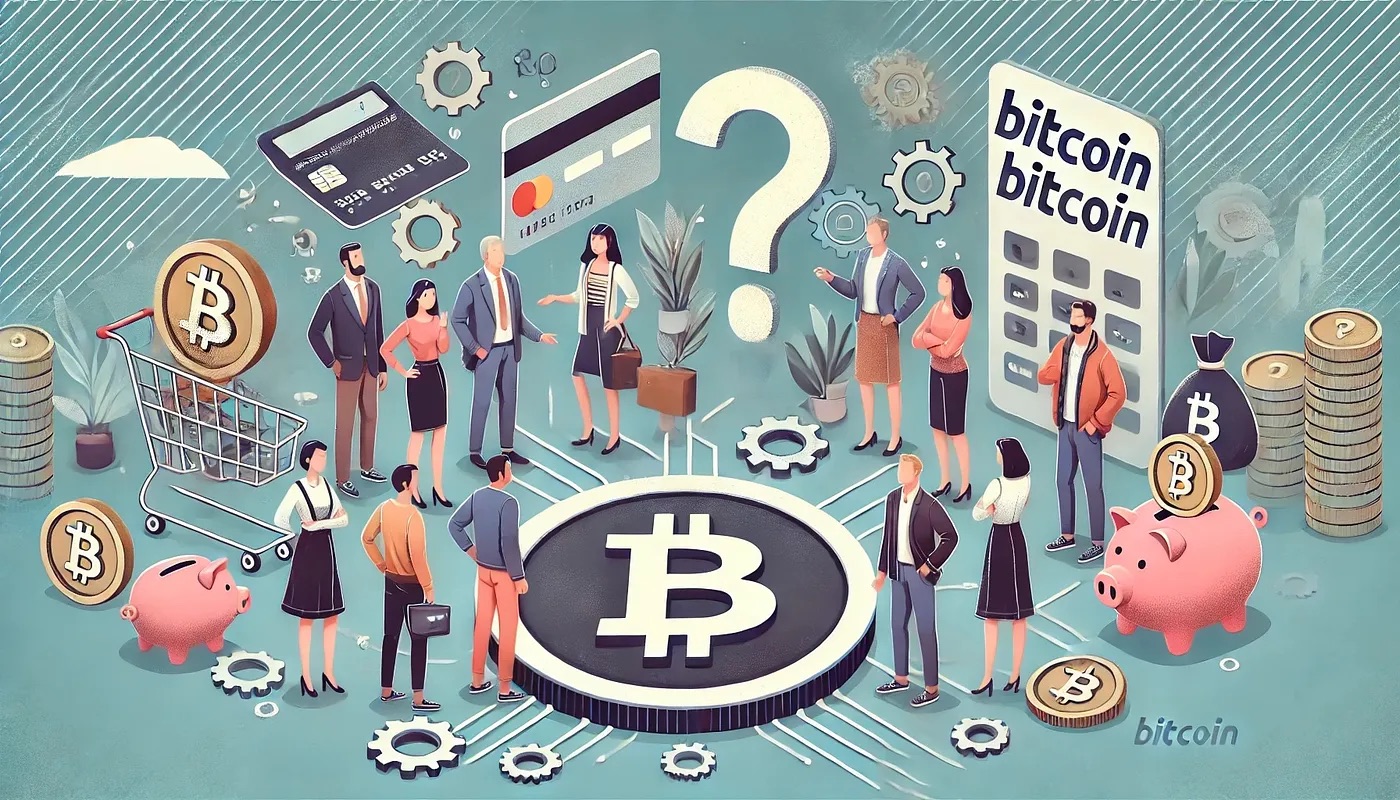Did you hear?
Despite giving people free Bitcoin, making it legal tender, and rolling out a universal BTC payment app, El Salvador’s government can’t get people to use it.

Does that surprise you? After all, the cryptosphere said that people will use Bitcoin once they realize how good it is.
That didn’t happen.
Is Bitcoin not as good as they thought? Or is something bigger going on?
They ain’t changin’ for ya
Last month, somebody needed to send me a lot of money.
He couldn’t use Zelle, didn’t have a checkbook, and didn’t want to pay a $25 wire fee.
Venmo would’ve taken many batches over many days, and I didn’t want to pay 3% to a payment processor to take his credit card.
I mentioned he could open a Coinbase account and use USDC to send me the money for free, in full, instantly.
He laughed.
In the end, he paid $10 to overnight a paper cashier’s check through USPS priority mail.
(And you think ETH fees are high!)
DALL-E drew a cartoon about it:
Uphill battle
People are strange. They will go through all sorts of inconveniences to stick with what they know.
Crypto peeps go on and on about usability and product-market fit, but that’s a big hurdle.
Ask anybody who’s had to guide Aunt Sally and Uncle Morton through their iPhone settings. They can tell you it takes more than a good interface and UX. You need to give people a compelling reason to switch.
(For Aunt Sally and Uncle Morton, those reasons are Facebook, Facetime, and text messages.)
We’re still trying to find that killer app or service that gives people a compelling reason to switch.
Like pushing an ox up a mountain
For your average person, Bitcoin seems slow, expensive, complicated, and they can’t spend it on most of the things they want.
Of course, you can say the same about checks, but not really. There’s a big difference.
Everybody’s used to checks.
They’re normal. When you handle checks, you don’t have to learn anything new. You don’t even need to know how to balance a checkbook anymore — most banks handle all the paperwork and tracking for you.
In fact, banks spend a lot of time and effort to make checking as easy as possible. They design the experience so you don’t think about fees, costs, and risks. Some even throw in a complimentary starter pack when you open your account (replacement books cost $10 and up).
Usually, banks include debit cards and free ATM access. That way, you never have to actually use those checks — which is good, because most businesses don’t take checks anyway.
Unless you’re poor, banks will usually waive your first bounced-check fee and rarely charge to stop payment on a check. If you give them enough money, they won’t even charge maintenance fees on your account.
Traditional banking has several centuries head start on Bitcoin when it comes to customer service and user experience — which isn’t saying much, as anybody who’s gone to a bank can tell you.
But banking is so common that most people have no other frame of reference. Over 90% of Americans have a bank account, as does half of the rest of the world.
Giving away Bitcoin only makes people wonder WTF the big deal is. Can you blame them? After all, if it’s so good, why do you need to give it away?
The value of something you got for free
Allow me to share three short stories about three real people who’ve gotten Bitcoin as gifts. I changed their names because somebody said I’m supposed to do that when I write about people online without their permission.
Louise, the baby boomer
Louise got 1 Bitcoin from her son. She keeps it in a Coinbase account on her phone.
Despite multiple tutorials and lots of handholding, she still does not know how to use it. She wonders why its price goes up and down like crazy.
When I asked her what she planned to do with it, she said she would keep it in her Coinbase wallet because her son says it might be worth something someday.
“Who knows? It went from nothing to $70,000, it might do that again!”
She doesn’t care about open, public, permissionless, borderless, neutral, censorship-resistant financial networks. Her son gave her a Bitcoin and said, “hold onto it.”
She has plenty of money and did nothing to earn that Bitcoin. Why would she care about it?
Oslo, the curious
Oslo asked me for advice about buying Bitcoin. I helped him out. Even sent him a few thousand sats as a gift after he set up his wallet.
Now that he has his coins, he complains about how hard it was to set up and that nobody else uses it.
He told me he’ll keep the Bitcoin for his kids. After all, it might be useful one day and everybody says it’ll go up.
Maybe his kids will appreciate him for it, but that doesn’t do anybody any good right now.
Mallory, the idiot
Mallory won’t mind me calling him an idiot because he’s an old friend of mine. And really, he’s not an idiot. He’s just simple.
I bought him $18 worth of Bitcoin in 2018. I told him he could get his $18 back any time he wanted, on demand, any time. My gift to him. Or, keep the Bitcoin. His choice. No time limit.
Didn’t set him up with a wallet or anything, just sent .0021 Bitcoin to a new wallet I created. I have the keys, ready to turn them over as soon as he asks.
That Bitcoin’s still sitting in that wallet. The keys are still securely mine.
At one point, the price of that .0021 Bitcoin dipped down to $7.35. He could’ve taken my $18, bought himself his own Bitcoin, and ended up way ahead.
Nope.
Now, that Bitcoin’s worth about $140. He doesn’t care.
If Bitcoin’s price goes to $1 million like everybody says, he’ll have $2,100. Just for being my friend.
I’ll bet he still won’t collect it. Why?
“I don’t know how to use it” and “if you think it’ll go up, I’ll hold it.”
Bitcoin isn’t good enough yet
As new technology develops, it usually moves from hard, complicated, and interesting to easy, simple, and boring.
Easy, simple, and boring is good.
Almost every mainstream thing is easy, simple, and boring. That’s how you know your technology has arrived.
Bitcoin’s not there yet. Like all new tech, it has to cross the “chasm of adoption,” as shown on this diagram of the technology adoption life cycle:
Sometimes, technology falls into the chasm and dies — but usually, good technologies survive and prosper. It just takes a while to catch on.
After 15 years of moving from enthusiasts to visionaries, Bitcoin has entered the chasm.
Medium writer Omar M. Khateeb posits that within that chasm, there are four stages: Complacency/Marginalization, Ridicule, Criticism, and Acceptance. You can see it in that bell curve above the chasm, also shown below:
Source: The 4 Stages to Technology Adoption Inside the Chasm
If Omar’s right, we’re probably at the “criticism” stage. Should we really push people to use Bitcoin now, when it’s still slow, complicated, and you can’t do much with it?
Probably not.
We need to get to acceptance, but Bitcoin needs to earn that. A lot of money’s going into memecoins, smart contract platforms, Bitcoin spin-offs, and other tokens. That takes money from people who are working to make Bitcoin faster, cheaper, better, easier, and more useful.
Once people lose enough money on these alternatives, the survivors will have to come back to Bitcoin. More do so with each cycle (however you define cycle).
If that bothers you, look on the bright side. If Bitcoin’s really as good as everybody says it is, those people will come around.
It just may take them longer than you’d like.
Mark Helfman publishes the Crypto is Easy newsletter. He is also the author of three books and a top Bitcoin writer on Medium and Hacker Noon. Learn more about him in his bio and connect with him on Tealfeed.



